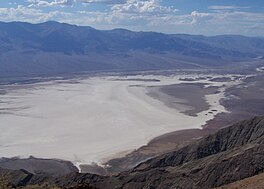| Badwater Basin | |
|---|---|
 View of Badwater Basin from Dante's View | |
| Location | Death Valley Inyo County, California |
| Coordinates | 36°15′01″N 116°49′33″W / 36.25028°N 116.82583°W |
| Type | Endorheic basin |
| Primary inflows | Amargosa River |
| Primary outflows | Terminal (evaporation) |
| Basin countries | United States |
| Max. length | 7.5 miles (12 km) |
| Max. width | 5.0 miles (8 km) |
| Surface elevation | −282 ft (−86 m)[1] |
| Settlements | Badwater, California |
| References | U.S. Geological Survey Geographic Names Information System: Badwater Basin |
Badwater Basin is an endorheic basin in Death Valley National Park, Death Valley, Inyo County, California, noted as the lowest point in North America and the United States, with a depth of 282 ft (86 m) below sea level.[1][2] Mount Whitney, the highest point in the contiguous United States, is only 84.6 miles (136 km) to the northwest.[3]
The site itself consists of a small spring-fed pool of "bad water" next to the road in a sink; the accumulated salts of the surrounding basin make it undrinkable, thus giving it the name. The pool does have animal and plant life, including pickleweed, aquatic insects, and the Badwater snail.
Badwater Crater, the lowest place on the planet Mars, is named after the basin due to their similarities.[4][5] Adjacent to the pool, where water is not always present at the surface, repeated freeze–thaw and evaporation cycles gradually push the thin salt crust into hexagonal shapes.
The pool is not the lowest point of the basin: the lowest point (which is only slightly lower) is several miles to the west and varies in position, depending on rainfall and evaporation patterns. The salt flats are hazardous to traverse (in many cases being only a thin white crust over mud), and so the sign marking the low point is at the pool instead. The basin was considered the lowest elevation in the Western Hemisphere until the discovery of Laguna del Carbón in Argentina at −344 ft (−105 m).
- ^ a b "Highest and Lowest Elevations". United States Geological Survey. Retrieved April 26, 2021.
- ^ USGS. Badwater Quadrangle, California (Topographic map). 1:24000. 7.5 minute. Retrieved April 29, 2021.
- ^ "Find Distance and Azimuths Between 2 Sets of Coordinates (Badwater 36-15-01-N, 116-49-33-W and Mount Whitney 36-34-43-N, 118-17-31-W)". Federal Communications Commission. Retrieved August 13, 2010.
- ^ "Planetary Names". planetarynames.wr.usgs.gov. Retrieved June 16, 2023.
- ^ Tanaka, Kenneth L.; Coles, Kenneth S.; Christensen, Philip R., eds. (2019), "Hellas (MC-28)", The Atlas of Mars: Mapping its Geography and Geology, Cambridge: Cambridge University Press, pp. 222–227, doi:10.1017/9781139567428.033, ISBN 978-1-139-56742-8, S2CID 243430036, retrieved June 16, 2023
